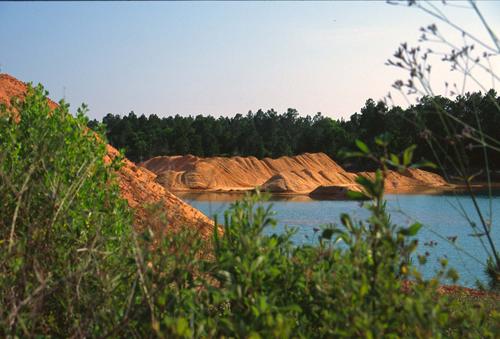
(Credit: No name provided, USGS. Public domain, no endorsement)
By Stephen Venneman, Staff Writer for Save The Water™ May 21, 2019
Although phosphate mining’s industry leaks from massive, radioactive waste threaten to pollute the Floridian Aquifer, the aquifer is one of the most productive in the world. In fact, the Floridian Aquifer provides drinking water throughout Florida as well as parts of Alabama, Georgia, and South Carolina.1 Between 2016 and 2019, two spills of radioactive waste from industrial sites endangered these waters. What do these two sites have in common? Both are owned by Mosaic Company, one of the world’s leading producers of in-demand chemicals used in fertilizers around the world.3 Above all, however, there are five actions you can take to help keep water safe.
Phosphate Mining in Florida: Radioactive Mountains
Florida leads the nation in phosphate mining. In fact, the majority of the state’s 27 mines are located in a 1.3 million acre area known as Bone Valley, which is about 30 miles outside Tampa. At these sites, sulfuric acid is applied to phosphoric ore, which converts to phosphoric acid.4 The process releases small amounts of uranium and radium, called phosphogypsum.
The Environmental Protection Agency (EPA) considers phosphogypsum to be radioactive. As a result, EPA requires that mining companies store it in above-ground stacks to prevent radon gas as well as uranium and radium, which are known to cause cancer and other health problems, from seeping into the environment.2
Simply put, these stacks are mountains of phosphogypsum, typically with a 40-to 80-acre pool of acidic water at the top. The mining process has generated enough phosphogypsum for 25 or more man-made mountains. This amounts to more than a billion tons of waste. But the stakeholders, including the industry and local communities, have no long-term solution for what to do with it all. The radioactive liquid could enter an aquifer and contaminate a city’s drinking water. If it does, the health hazards include kidney damage as well as an elevated risk of developing cancer–and, in extreme cases, death.5
Calling a Spade a Spade: Call a Spill a Spill in Phosphate Mining
In 2016, a storage tank at a fertilizer plant in Mulberry, Florida leaked wastewater. The leak dumped 215 million gallons of water polluted with acidic phosphogypsum into the aquifer. Later, in 2019, a fertilizer plant in Louisiana reported that a 300-acre, 200-foot high mountain of gypsum, a mineral used in fertilizers as well as blackboard chalk, was slumping. In other words, the gypsum pile threatens to spill 700 million gallons of acidic water into the environmentally-sensitive Blind River and the Maurepas Swamp in Louisiana.2
Mosaic Company owns both of these sites. But Mosaic Company is not the only company doing phosphate mining in the United States. Certainly, many mining companies across the country have long records of environmental degradation and apparent disregard for public health. You can read more about some of that in Publishing Director April Day’s Save the WaterTM article Phosphate Mining and Public Consultation: This Land is My Land for Mining.
Most noteworthy, some mining company officials and state inspectors remain reluctant to call these events what they are: spills. For example, in the 2016 spill in Mulberry, Florida, state and company spokespersons waited ten days before even saying the word “spill.” In fact, they called the event a “spill” only after the stack was drained; by then, people could actually see the sinkhole. Even then, the public wasn’t notified until late September.6
Rather than asking, “what can we do better,” the phosphate mining industry keeps doing the same thing. Simply put, when a company won’t call a spill “a spill” for more than a week, the refusal delays the containment effort. Moreover, the tactic increases the chance that radioactive uranium could end up coming out of your kitchen sink. The delay isn’t necessary.
What You Can Do: 5 Things You Can Do Now
Here is a list of things you can do to help keep your drinking water safe:
- Get your city’s water quality report from the Public Works or Public Utility office.
- Conduct regular water tests every five years.
- Let your state representatives know water quality is important to you.
- Let your city planners, zoning offices, and City Council know water quality is important to you.
- Get informed and stay informed. Follow Save The WaterTM on social media.
References
- Kevin Byrne. September 21, 2016. “Contaminated water seeps into Florida aquifer after giant sinkhole opens at Mosaic plant.” Accuweather. https://www.accuweather.com/en/weather-news/contaminated-water-seeps-into/60143695
- Mark Schleifstein. January 29, 2019. “Acid water atop slumping Uncle Sam gypsum pile threatens swamps.“ The Times-Picayune. https://www.nola.com/environment/2019/01/acid-water-atop-slumping-uncle-sam-gypsum-pile-threatens-swamps.html
- “Who We Are.” Mosaic Company. http://www.mosaicco.com/Who_We_Are/overview.htm
- Jaclyn Lopez. September 19, 2016. “Column: It’s time to rein in Florida’s phosphate strip mining.” Tampa Bay Times. https://www.tampabay.com/opinion/columns/column-its-time-to-rein-in-floridas-phosphate-strip-mining/2294257
- National Center for Environmental Health. October 26, 2016. “Drinking Water.” U.S. Department of Health and Human Services. https://ephtracking.cdc.gov/showUraniumHealth
- Craig Pittman. April 26, 2017. “The clock is ticking on Florida’s mountains of hazardous waste.” Sarasota Magazine. https://www.sarasotamagazine.com/articles/2017/4/26/florida-phosphate

